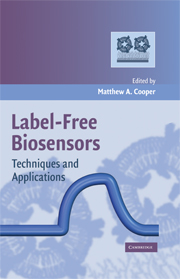Book contents
- Frontmatter
- Contents
- Contributors
- Preface
- LABEL-FREE BIOSENSORS
- 1 Label-free optical biosensors: An introduction
- 2 Experimental design
- 3 Extracting affinity constants from biosensor binding responses
- 4 Extracting kinetic rate constants from binding responses
- 5 Sensor surfaces and receptor deposition
- 6 Macromolecular interactions
- 7 Interactions with membranes and membrane receptors
- 8 Application of SPR technology to pharmaceutical relevant drug-receptor interactions
- 9 High-throughput analysis of biomolecular interactions and cellular responses with resonant waveguide grating biosensors
- 10 ITC-derived binding constants: Using microgram quantities of protein
- 11 Electrical impedance technology applied to cell-based assays
- Index
- Plate section
10 - ITC-derived binding constants: Using microgram quantities of protein
Published online by Cambridge University Press: 05 May 2010
- Frontmatter
- Contents
- Contributors
- Preface
- LABEL-FREE BIOSENSORS
- 1 Label-free optical biosensors: An introduction
- 2 Experimental design
- 3 Extracting affinity constants from biosensor binding responses
- 4 Extracting kinetic rate constants from binding responses
- 5 Sensor surfaces and receptor deposition
- 6 Macromolecular interactions
- 7 Interactions with membranes and membrane receptors
- 8 Application of SPR technology to pharmaceutical relevant drug-receptor interactions
- 9 High-throughput analysis of biomolecular interactions and cellular responses with resonant waveguide grating biosensors
- 10 ITC-derived binding constants: Using microgram quantities of protein
- 11 Electrical impedance technology applied to cell-based assays
- Index
- Plate section
Summary
INTRODUCTION
Isothermal titration calorimetry (ITC) has gained wide acceptance in drug discovery and development laboratories throughout the world. Every major pharmaceutical company and most biopharmaceutical companies and major research institutions now use ITC. Modern, highly sensitive ITC instruments are being applied in the drug discovery and development process for applications such as: (a) selection of small-molecule “hits” following primary and secondary screening of chemical libraries against protein targets of interest, (b) optimization of smallmolecule leads based on elucidation of the binding mechanism and binding characteristics and development of structure–activity relationships (SAR) used in the optimization process, and (c) selection and optimization of therapeutic protein variants.
Because ITC directly measures the heat released or absorbed during a biomolecular binding event, it is the only technique that allows simultaneous determination of all thermodynamic binding parameters (n, KA, ΔH and ΔS) in a single experiment. The ITC technique provides this unique capability in an experimental environment that is label-free, in solution, and that does not require immobilization of either the target macromolecule or ligand. Modern instruments are highly sensitive, accurate, and reproducible, and unlike spectroscopic methods, the degree of optical clarity of the solutions is unimportant. As modern ITC instrumentation has evolved, these instruments have become more sensitive, faster, and easier to use. Binding parameters determined by ITC are often referred to as “gold standard” values and are frequently used as reference standard values for other techniques.
Despite the fundamental advantages of this technique and the advances in instrumentation, use of ITC in the early, critical decision-making stages of drug discovery is often limited.
Information
- Type
- Chapter
- Information
- Label-Free BiosensorsTechniques and Applications, pp. 223 - 250Publisher: Cambridge University PressPrint publication year: 2009
Accessibility standard: Unknown
Why this information is here
This section outlines the accessibility features of this content - including support for screen readers, full keyboard navigation and high-contrast display options. This may not be relevant for you.Accessibility Information
- 5
- Cited by
